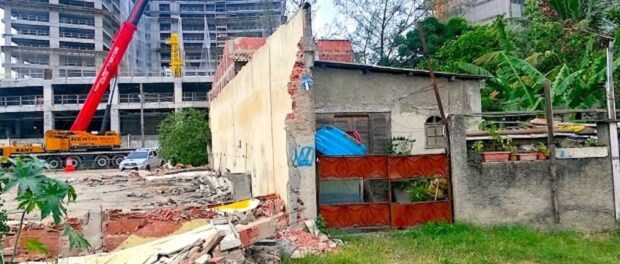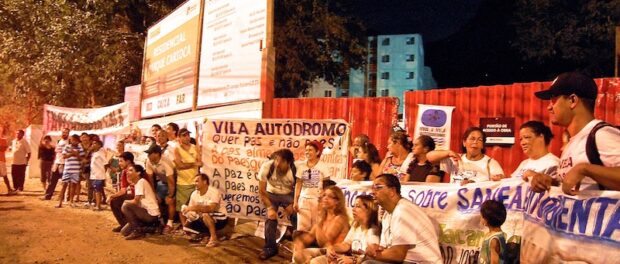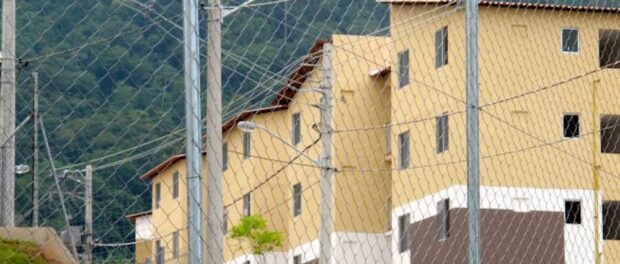
This is the final article in a six-part series that comprises the book chapter entitled “Not Everyone Has a Price: How the Small Favela of Vila Autódromo’s Fight Opened a Path to Olympic Resistance” recounting the story of Vila Autódromo’s struggle. Written by Theresa Williamson, executive director of Catalytic Communities,* the chapter is part of the book ‘Rio 2016: Olympic Myths, Hard Realities‘ edited by economist Andrew Zimbalist. To read our review of ‘Rio 2016,’ click here. RioOnWatch would like to thank Brookings Press for providing the permission to republish the chapter here in its entirety. Read the full chapter, from the beginning, here.
Unfortunately, Vila Autódromo represents just one of dozens of communities that suffered forced evictions in the lead-up to the 2016 Olympic Games. In all, nearly 80,000 people were removed. Two to three thousand of these were from Vila Autódromo. By some estimates more people were evicted in the pre-Olympics years in Rio than in both previous Rio administrations associated with evictions combined: those of Francisco Pereira Passos in the first decade of the 1900s and Carlos Lacerda in the 1960s.
The Olympic Games offered the perfect pretext for eviction. Over the previous century favela residents had acquired basic land rights, and their communities were being slowly upgraded under the growing conclusion that this was the only way to justly integrate them. Opportunities for mass eviction would no longer be justifiable—that is, until the Olympics deadline provided a state of exception.1 The city’s population yearned for investment. There was a broad assumption that municipal decisions were being well made in the public interest. And there were few checks to make sure they were.
So as city workers pulled up at favelas from Recreio II to Metrô, Manguinhos to Harmonia, Tanque to Restinga, few residents resisted. Most did not know they had any rights to claim, often struggling to make ends meet from multiple jobs or hampered by little education. Twenty-six percent of evictees during this period were in and near the rapidly expanding upper-class Barra da Tijuca region, despite this region only housing 12 percent of the city’s favela residents. Evictees were generally bused to distant housing projects in the extreme West Zone of Rio de Janeiro, in neighborhoods like Cosmos and Santa Cruz, two hours from employment opportunities and now at the mercy of vigilante cop mafias, known in Rio as milicias. In other cases, the government offered rent subsidies of R$400 per household (about $120) per month, insufficient to rent a favela home in most of Rio de Janeiro.
Vila Autódromo’s strategy relied on seven keys to successful resistance:
- The community’s relative unity in its commitment to stay;
- Access to information;
- Legal defense;
- Diverse and resolute leadership;
- Broad networks of support ranging from peer communities to technical partners;
- Creative responses such as the Popular Plan and Evictions Museum; and
- Early and ongoing documentation and visibility.
This broader context helps put Vila Autódromo’s remarkable resistance into perspective. The community carved out a strategy to resist greed of Olympic proportions that relied on seven keys to successful resistance: the community’s relative unity in its commitment to stay, access to information,[a] legal defense, diverse and resolute leadership, broad networks of support ranging from peer communities to technical partners, creative responses such as the Popular Plan and Evictions Museum, and early and ongoing documentation and visibility.
Residents will attribute the success at each moment of their struggle to one or the other of these keys to resistance. For example, in the first year the community’s legal defense was the most critical, in particular allowing the community time to organize on other fronts. And as the struggle went on, creative responses allowed them to solidify their commitment, become more united, and get over psychological hurdles while attracting partners and media attention. And finally, mass attention from the global media and broad networks of support emboldened residents during their most trying period,[b] when so many of their neighbors had been removed, services were cut, and demolition debris left morale low. And all along, it was the community’s diverse and resolute leadership, able to evolve and adapt among a large number of compelling community members as the struggle continued, that resulted in the relative success of the final outcome.
Though ultimately dismantled in virtually its entirety, Vila Autódromo’s victories in the broad context of the history of Rio de Janeiro’s favelas and housing rights in Brazil as a whole (and perhaps ultimately around the world) are many and its lessons far-reaching.
Vila Autódromo was up against the most powerful real estate interests in Brazil, one of the world’s most unequal societies. Yet its battle was uniquely successful on numerous levels. Oversold as some sort of paradise, Parque Carioca was nonetheless one of the better examples of public housing built under the Paes administration, and those who moved there were able to remain in the same region as their jobs and schools. In many cases, families moving to Parque Carioca received multiple apartments—one per adult child plus the parents and grandparents, for example. And there were those who received market-rate compensation, the first-ever favela compensations recognizing land value in Rio’s history.
Finally, and perhaps most importantly, those twenty families who remained to the end were able to prove to those who gave up—perhaps ultimately more importantly to communities at threat elsewhere— that firm, creative resistance pays off. And they signed their agreement collectively, rather than individually with the city.
The Rio Olympics proved that, at least somewhere, not everyone has a price. The Games have also inadvertently spread that gospel.
Click here for our Timeline of Vila Autódromo’s Story of Resistance
This is the final article in a six-part series that comprises the chapter entitled “Not Everyone Has a Price: How the Small Favela of Vila Autódromo’s Fight Opened a Path to Olympic Resistance” recounting the story of Vila Autódromo’s struggle. The chapter is part of the book ‘Rio 2016: Olympic Myths, Hard Realities.’ RioOnWatch would like to thank Brookings Press for providing the permission to republish the chapter here in its entirety.
Notes
[a] Information that bolstered the community included knowledge of their rights and organizing strategies, as well as the fundamental awareness to distrust what would turn out to be empty political promises, and a firm sense of the consequences and what would be lost were they to be evicted.
[b] A Google News search on May 5, 2017 for “Vila Autódromo” yields more than 11,500 results.
Additional Bibliographic References
[1] Jake Cummings, “Confronting Favela Chic: The Gentrification of Informal Settlements in Rio de Janeiro, Brazil,” in Global Gentrifications: Uneven Development and Displacement, edited by Loretta Lees, Hyun Bang Shin, and Ernesto López-Morales (Bristol: Policy Press, 2015), pp. 81–99, at 84.
Complete Series: Not Everyone Has a Price: The Story of Vila Autódromo’s Olympic Struggle
Part 1: (Re)Introducing Favelas
Part 2: Introducing Vila Autódromo
Part 3: Vila Autódromo’s Rise as a Symbol of Olympic Resistance (2010-2012) [VIDEO]
Part 4: Intimidation and the Critical Turning Point (2013-2014) [VIDEO]
Part 5: The City Proceeds with Eminent Domain and Violence (2014-2016) [VIDEO]
Part 6: Conclusion—Vila Autódromo in the Context of Rio’s Olympic Evictions
Also see: Timeline of Vila Autodromo
*RioOnWatch is a project of the NGO Catalytic Communities



